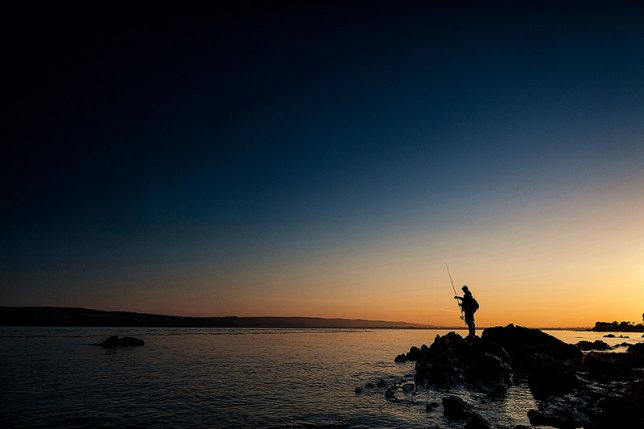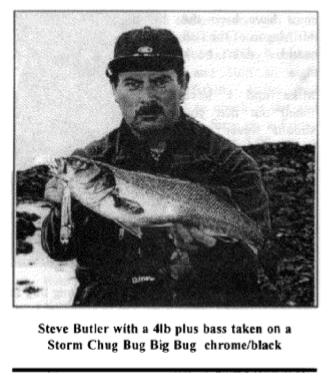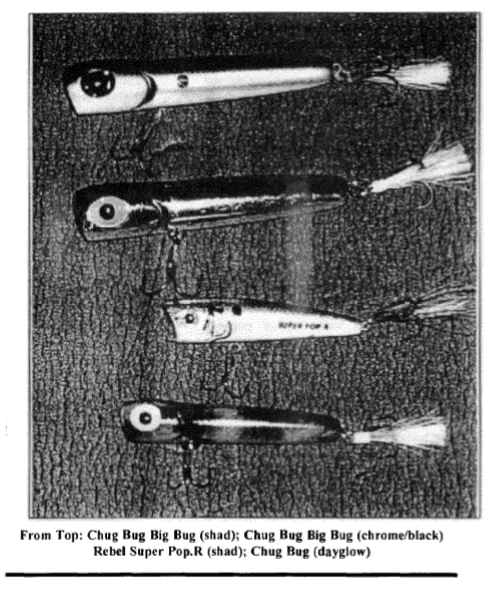CHAPTER 3 – TECHNIQUES – LURE FISHING
Using Surface Poppers
Over one bass season Mike Hughes and I experimented with surface popper lures. Fishing over a wide range of different grounds, kelp beds, shallow and deep rocky areas, clean sand and tidal flow water, has resulted in fish from 2lb to 9lb from all grounds.

Surface poppers do have advantages over diving lures, in that obviously they do not dive and just work along the water’s surface, so they can be worked over ground you would not dream of casting your diving lure. The surface poppers we experimented with were Lucky 13, Mirrolure 88mm, Mirrolure 12m, Rebel Super Pop-r and the Storm Big Bug. The popper we found to be in a class of its own and had the most success with was the Storm Big Bug. At 41/2 inches in length and 7/8 oz weight it is a fish catcher. I had a few fish on the Mirrolure 88mm but the Big Bug is a superior lure, it casts very well being 7/8 oz in weight and looks realistic on the waters surface when worked to its full potential.
 Your main aim with your popper is to make it look like an injured fish, splashing on the water’s surface so it looks an easy meal for a bass to snap up; and believe me they do. Calm weather and a flat sea are the best conditions to use your popper, but it can score if the surface is rippled or if there is a fine chop.
Your main aim with your popper is to make it look like an injured fish, splashing on the water’s surface so it looks an easy meal for a bass to snap up; and believe me they do. Calm weather and a flat sea are the best conditions to use your popper, but it can score if the surface is rippled or if there is a fine chop.
Cast out to your selected area where you think the feeding fish will be. Then jerk your lure violently to make as much commotion on the water surface as possible for 5 or 6 seconds, then leave your lure still and motionless in the water for 3 or 4 seconds, (the splashing gives the bass something to home in on) then twitch your lure gently for about the 1/5th of the retrieve, leave motionless for 2 or 3 seconds, then violently jerk your lure for another 3 or 4 seconds then leave motionless again for 2 or 3 seconds, then work the lure with twitches for the rest of the retrieve, pausing for 3 or 4 seconds just before lifting it out of the water.
A bass can attack your lure at any time from when you first start working it, to when you lift it out of the water. Bass often take when the popper is motionless between jerks. A bass taking a popper can give you one hell of a fight, and when a large bass comes out of the water with your popper in its mouth right in front of you, it’s a fantastic sight! I had one bass attack my popper and make 5 savage attacks, missing the lure on each occasion. It must have been the ‘Mr Magoo’ of the fish world, I didn’t hook it.
 Mike and I found that you should never take your eye off your lure at any time when working it, and be sure to check for swirls behind your lure, as a bass usually attacks after it swirls behind your popper. Try to work out the difference between the swirl your lure will make and the swirl a bass will make. Remember, when you see a swirl be on your guard; it makes you more alert when you know a bass is around. One thing I would like to say about poppers is that you will not hook every fish that attacks your lure, the hooking rate is not as high as you will get with sub-surface lures. At the same time we experimented with braid for a season, and it certainly has advantages with this type of fishing. As there is hardly any stretch with braid, we found we had a higher hooking rate than with mono. There are different fibre formats with different stiffness, various levels of abrasion resistance, and a host of brands to choose from, so I advise you to experiment yourself to find the right one for you.
Mike and I found that you should never take your eye off your lure at any time when working it, and be sure to check for swirls behind your lure, as a bass usually attacks after it swirls behind your popper. Try to work out the difference between the swirl your lure will make and the swirl a bass will make. Remember, when you see a swirl be on your guard; it makes you more alert when you know a bass is around. One thing I would like to say about poppers is that you will not hook every fish that attacks your lure, the hooking rate is not as high as you will get with sub-surface lures. At the same time we experimented with braid for a season, and it certainly has advantages with this type of fishing. As there is hardly any stretch with braid, we found we had a higher hooking rate than with mono. There are different fibre formats with different stiffness, various levels of abrasion resistance, and a host of brands to choose from, so I advise you to experiment yourself to find the right one for you.
Since the experiments other poppers have come into popular use, notably the Duel Aile Magnet, Yo-Zuri Mag Popper, and Chico Boco, and the experiments continue.
Author: Steve Butler
Historical note: This article was published in BASS magazine no.86 May 1998. The article was titled ‘Using the Chug Bug Big Bug‘
© Bass Anglers’ Sportfishing Society 2008